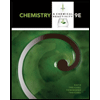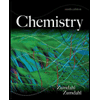
CHM 101 VOL 1 2014 >IC<
17th Edition
ISBN: 9781269932905
Author: Pearson
Publisher: PEARSON C
expand_more
expand_more
format_list_bulleted
Concept explainers
Textbook Question
Chapter 9, Problem 74E
Indicate whether each statement is true or false.
- s orbitals can only make a or m molecular orbitals.
- The probability is 100% for finding an electron at the nucleus a orbital.
- Antibonding orbitals are higher in energy than bonding orbitals (if all orbitals are creat the same atomic orbitals).
- Electrons cannot occupy an antibonding orbita.
Expert Solution & Answer
Want to see the full answer?
Check out a sample textbook solution
Students have asked these similar questions
Pls help me on this q.
Given the elementary reactions in an aqueous medium with an ionic strength of 0.001:1) CH3Br + OH- → CH3OH + Br-2) ClCH2COO- + OH- → HOCH2COO- + Cl-3) [Co(NH3)5Br]2+ + NO2- →[Co(NH3)5NO2]2+ + Br-If the ionic strength is decreased, 1) k will not change; 2) k will decrease; and 3) k will increase. Is this correct?
Relate zero ionic strength and infinite dilution limit.
Chapter 9 Solutions
CHM 101 VOL 1 2014 >IC<
Ch. 9.2 - Consider the following AB3 molecules and ions-...Ch. 9.2 - Prob. 9.1.2PECh. 9.2 - Prob. 9.2.1PECh. 9.2 - Prob. 9.2.2PECh. 9.2 - Prob. 9.3.1PECh. 9.2 - Prob. 9.3.2PECh. 9.3 - Prob. 9.4.1PECh. 9.3 - Determine whether the following molecules are...Ch. 9.5 - Prob. 9.5.1PECh. 9.5 - Prob. 9.5.2PE
Ch. 9.6 - Prob. 9.6.1PECh. 9.6 - Prob. 9.6.2PECh. 9.6 - Prob. 9.7.1PECh. 9.6 - Prob. 9.7.2PECh. 9.7 - Prob. 9.8.1PECh. 9.7 - Prob. 9.8.2PECh. 9.8 - Prob. 9.9.1PECh. 9.8 - Prob. 9.9.2PECh. 9 - Prob. 1DECh. 9 - 9.1 A certain AB4, molecule has a "seesaw" shape...Ch. 9 - Prob. 2ECh. 9 - Prob. 3ECh. 9 - Prob. 4ECh. 9 - Prob. 5ECh. 9 - Prob. 6ECh. 9 - In the hydrocarbon a. What is the hybridization at...Ch. 9 - The drawing below shows the overlap of two hybrid...Ch. 9 - Prob. 9ECh. 9 -
9.10 The following is part of a molecular...Ch. 9 - Prob. 11ECh. 9 - Prob. 12ECh. 9 -
9.13
a. An AB2 molecule is linear. How...Ch. 9 - a. Methane (CH4) and the perchlorate ion (C104-)...Ch. 9 - Prob. 15ECh. 9 - Prob. 16ECh. 9 - Prob. 17ECh. 9 - Prob. 18ECh. 9 - In which of these molecules or ions does the...Ch. 9 - Prob. 20ECh. 9 - How many nonbonding electron pairs are there in...Ch. 9 - Prob. 22ECh. 9 - Prob. 23ECh. 9 - Prob. 24ECh. 9 - Give the electron-domain and molecular geometries...Ch. 9 - Prob. 26ECh. 9 - Prob. 27ECh. 9 - Prob. 28ECh. 9 - Prob. 29ECh. 9 - Prob. 30ECh. 9 - Ammonia, NH3 reacts with incredibly strong bases...Ch. 9 - In which of the following AFn molecules or ions is...Ch. 9 - a. Explain why BrF4 is square planar, whereas...Ch. 9 -
9.34 Name the proper three-dimensional molecule...Ch. 9 - Prob. 35ECh. 9 - Prob. 36ECh. 9 - Prob. 37ECh. 9 - Prob. 38ECh. 9 - a. (a) Is the molecule BF3 polar or nonpolar? b....Ch. 9 - Prob. 40ECh. 9 - Predict whether each of the following molecules is...Ch. 9 - Prob. 42ECh. 9 - Prob. 43ECh. 9 - Prob. 44ECh. 9 - For each statement, irldicate whether it is true...Ch. 9 - Draw sketches illustrating the overlap between the...Ch. 9 - For each statement, indicate whether it is true or...Ch. 9 - Prob. 48ECh. 9 - Prob. 49ECh. 9 - Consider the SC12 molecule. a. What IS the...Ch. 9 - Indicate the hybridization of the central atom in...Ch. 9 - Prob. 52ECh. 9 - Prob. 53ECh. 9 - Prob. 54ECh. 9 - Prob. 55ECh. 9 - Prob. 56ECh. 9 - a. Draw Lewis structures for ethane (C2He),...Ch. 9 - a. Draw Lewis structures for ethane (C2He),...Ch. 9 - Prob. 59ECh. 9 - Ethyl acetate. C4H802, is a fragrant substance...Ch. 9 - Prob. 61ECh. 9 - Prob. 62ECh. 9 - Prob. 63ECh. 9 - Prob. 64ECh. 9 - In the formate ion, HC02- , the carbon atom is the...Ch. 9 - Prob. 66ECh. 9 - Prob. 67ECh. 9 - Prob. 68ECh. 9 - Prob. 69ECh. 9 - a. If you combine two atomic orbitals on two...Ch. 9 - Prob. 71ECh. 9 - Prob. 72ECh. 9 - Prob. 73ECh. 9 - Indicate whether each statement is true or false....Ch. 9 - Prob. 75ECh. 9 - Prob. 76ECh. 9 - Prob. 77ECh. 9 - Prob. 78ECh. 9 - Prob. 79ECh. 9 - Prob. 80ECh. 9 - Determine the electron configurations for CN+, CN,...Ch. 9 - Prob. 82ECh. 9 - Consider the molecular orbitals of the P2...Ch. 9 - The iodine bromide molecule, IBr, is an...Ch. 9 - Prob. 85AECh. 9 - Prob. 86AECh. 9 - Consider the following XF4 ions: PF4, BrF4-,...Ch. 9 -
9.88 Consider the molecule PF4Cl....Ch. 9 - Prob. 89AECh. 9 - Fill in the blank spaces in the following chart....Ch. 9 - Prob. 91AECh. 9 - Prob. 92AECh. 9 - Prob. 93AECh. 9 - Prob. 94AECh. 9 - Prob. 95AECh. 9 - Prob. 96AECh. 9 - Prob. 97AECh. 9 - Prob. 98AECh. 9 - Prob. 99AECh. 9 - Prob. 100AECh. 9 - In ozone, 03, the two oxygen atoms on the ends Of...Ch. 9 - Butadiene, C4H6, is a planar molecule that has the...Ch. 9 - The structure of borazine, B3N3H6, is a...Ch. 9 - Prob. 104AECh. 9 - Prob. 105AECh. 9 - Prob. 106AECh. 9 - Prob. 107AECh. 9 - Prob. 108AECh. 9 - Azo dyes are organic dyes that are used for many...Ch. 9 - a. Using only the valence atomic orbitals of a...Ch. 9 - Carbon monoxide, CO, is isoelectronic to N2. a....Ch. 9 - The energy-level diagram in Figure 9.36 shows that...Ch. 9 - A compound composed of 2.1 29.8%N, and 68.1%O has...Ch. 9 -
9.114 Sulfur tetrafluoride (SR4) reacts slowly...Ch. 9 - Prob. 115IECh. 9 - The molecule 2-butene, C4Hs, can undergo a...Ch. 9 - Prob. 117IECh. 9 - Use average bond enthalpies (Table 8.3 ) to...Ch. 9 - Prob. 119IECh. 9 - Prob. 120IECh. 9 - Prob. 121IECh. 9 - Prob. 122IE
Knowledge Booster
Learn more about
Need a deep-dive on the concept behind this application? Look no further. Learn more about this topic, chemistry and related others by exploring similar questions and additional content below.Similar questions
- The photolysis of H3C–N=N–C2H5 involves the breaking of the single bonds shown. According to this, in addition to N2, what products would be obtained primarily if the reaction were carried out in the gas phase or in solution in an inert solvent?arrow_forwardGiven a keto-enol tautomerization reaction, which is greatly influenced by the type of solvent, indicate which of the following solvent properties cannot be considered a "solvent effect"?(A) Dielectric constant(B) Polarity(C) Hydrogen bonding capacity(D) Temperaturearrow_forwardIn solution reactions, what does "solvent effect" mean?arrow_forward
- How to solvearrow_forwardIndicate the concentration and ionic strength ranges to which the Debye-Huckel equation can be applied. And the Davies equation?arrow_forwardIf the ionic strength (I) of a solution is very low, the Debye-Huckel equation is used. If I is higher, the Davies equation is used. What is the correct value for I to use one or the other?arrow_forward
- In both the Debye-Huckel equation and the Davies equation, there is a constant A. I see that sometimes it appears as 0.51 and other times as 1.02. Explain why one or the other value is used.arrow_forwardThe two equations are forms of the Davies equation, used in thermodynamics for activity coefficients: ال log Y₁ = -Az² - 0,31 log = Az² - 0,31 1 + √Ĩ 1 + √√ k These equations are consistent and imply that Yi = Is this last equation correct? karrow_forwardThe two equations are forms of the Davies equation, used in thermodynamics for activity coefficients: ال log Y₁ = -Az² - 0,31 log = Az² - 0,31 1 + √Ĩ 1 + √√ k These equations are consistent and imply that Yi = Is this last equation correct? karrow_forward
- For the Davies equation, both expressions are correct: log Y₁ = -Az² √i - 0,31 1 + √ k log- = Az - 0,31 k 1 + √Ĩarrow_forwardk In Davies' equation log y₁ = log- log y₁ = log | = -Az² + ✓// k A is a constant that always equals 1.02. Correct? - 0,31arrow_forwardIndicate whether the equality is true Yi How is it obtained? k%arrow_forward
arrow_back_ios
SEE MORE QUESTIONS
arrow_forward_ios
Recommended textbooks for you
 Chemistry: Principles and PracticeChemistryISBN:9780534420123Author:Daniel L. Reger, Scott R. Goode, David W. Ball, Edward MercerPublisher:Cengage Learning
Chemistry: Principles and PracticeChemistryISBN:9780534420123Author:Daniel L. Reger, Scott R. Goode, David W. Ball, Edward MercerPublisher:Cengage Learning Chemistry & Chemical ReactivityChemistryISBN:9781337399074Author:John C. Kotz, Paul M. Treichel, John Townsend, David TreichelPublisher:Cengage Learning
Chemistry & Chemical ReactivityChemistryISBN:9781337399074Author:John C. Kotz, Paul M. Treichel, John Townsend, David TreichelPublisher:Cengage Learning Chemistry & Chemical ReactivityChemistryISBN:9781133949640Author:John C. Kotz, Paul M. Treichel, John Townsend, David TreichelPublisher:Cengage Learning
Chemistry & Chemical ReactivityChemistryISBN:9781133949640Author:John C. Kotz, Paul M. Treichel, John Townsend, David TreichelPublisher:Cengage Learning Chemistry: An Atoms First ApproachChemistryISBN:9781305079243Author:Steven S. Zumdahl, Susan A. ZumdahlPublisher:Cengage Learning
Chemistry: An Atoms First ApproachChemistryISBN:9781305079243Author:Steven S. Zumdahl, Susan A. ZumdahlPublisher:Cengage Learning
 ChemistryChemistryISBN:9781305957404Author:Steven S. Zumdahl, Susan A. Zumdahl, Donald J. DeCostePublisher:Cengage Learning
ChemistryChemistryISBN:9781305957404Author:Steven S. Zumdahl, Susan A. Zumdahl, Donald J. DeCostePublisher:Cengage Learning

Chemistry: Principles and Practice
Chemistry
ISBN:9780534420123
Author:Daniel L. Reger, Scott R. Goode, David W. Ball, Edward Mercer
Publisher:Cengage Learning

Chemistry & Chemical Reactivity
Chemistry
ISBN:9781337399074
Author:John C. Kotz, Paul M. Treichel, John Townsend, David Treichel
Publisher:Cengage Learning

Chemistry & Chemical Reactivity
Chemistry
ISBN:9781133949640
Author:John C. Kotz, Paul M. Treichel, John Townsend, David Treichel
Publisher:Cengage Learning

Chemistry: An Atoms First Approach
Chemistry
ISBN:9781305079243
Author:Steven S. Zumdahl, Susan A. Zumdahl
Publisher:Cengage Learning


Chemistry
Chemistry
ISBN:9781305957404
Author:Steven S. Zumdahl, Susan A. Zumdahl, Donald J. DeCoste
Publisher:Cengage Learning
Stoichiometry - Chemistry for Massive Creatures: Crash Course Chemistry #6; Author: Crash Course;https://www.youtube.com/watch?v=UL1jmJaUkaQ;License: Standard YouTube License, CC-BY
Bonding (Ionic, Covalent & Metallic) - GCSE Chemistry; Author: Science Shorts;https://www.youtube.com/watch?v=p9MA6Od-zBA;License: Standard YouTube License, CC-BY
General Chemistry 1A. Lecture 12. Two Theories of Bonding.; Author: UCI Open;https://www.youtube.com/watch?v=dLTlL9Z1bh0;License: CC-BY